A magnet and current carrying conductor have magnetic field around it. If a magnet or other current carrying conductor exist in the magnetic field it experiences a force. Thus, we can say a magnetic field is a volume of space around a magnetic material or a moving electric charge, and within this space the force of magnetism acts.
Magnetic field around a permanent magnet is shown below.

Also when a current flows in a conductor, the moving charge carriers( electrons) creates a magnetic field around the conductor.
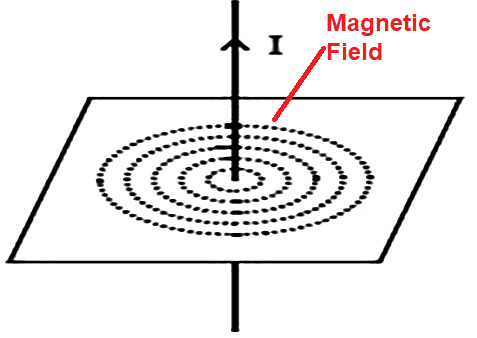
The magnetic field generates in the following conditions.
- Movement of electrons or charge carriers
- rotation of electrons at its own axis
- The spinning and orbiting of the nucleus of an atom
The major reason of the magnetic field generation is the motion of electric charge.
Unit of Magnetic Field
The magnetic field shows that there are magnetic force of lines around a magnet or a current carrying conductor. The flux density(B) and the field strength or field intensity(H) shows the magnetic field. Therefore, magnetic field can be expressed in terms of magnetic field intensity or in terms of magnetic flux density.
| Symbol | B or H |
| Unit | Tesla |
| Base unit | (Newton. Second)/Coulomb |
Magnetic field Explanation
There are two methods for explanation of the magnetic field.
- Magnetic Field Vector
- Magnetic Field Lines
Magnetic Field Vector
The magnetic field is basically a vector field. A vector has both direction and magnitude. It is possible to directly plot this vector field as a set of many vectors drawn on a grid. The direction of each vector is in the direction that a compass would point. The length of the vector depends on the strength of the magnetic force.
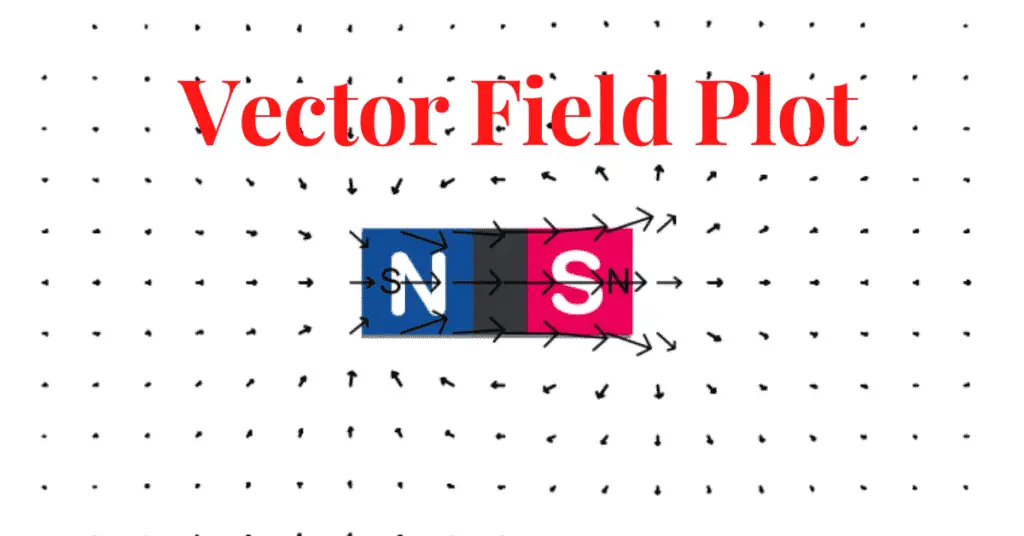
The compass placed on grid in a magnetic field only shows the direction. It does not show the strength of the magnetic field.
Magnetic Field Lines
The alternate way of representation of magnetic field is the magnetic field lines contain within the vector field. The magnetitic field lines are imaginary lines.
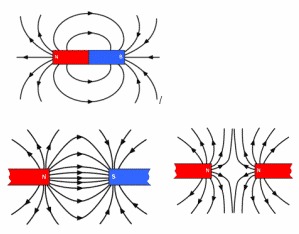
Field lines is an alternative way to represent the information contained within a magnetic vector field. Magnetic field lines are imaginary lines. We get the magnetic field lines when we connect the vectors with smooth lines. It is possible to draw as many lines as we want. The density of the magnetic lines of force indicates the magnitude of the field.
The magnetic field lines are crowded near the poles of the magnet. Therefore, the magnetic field is stronger near the poles and become weaker as we move way from the poles.
Properties of Magnetic Field Lines
The followings are the properties of magnetic field lines.
- The magnetic field lines never intersects. It means they never cross each other.
- The Magnetic field lines naturally bunch up in regions that has the strongest magnetic field. Thus, the density of field lines indicates the strength of the field.
- The magnetic field lines form a closed loop.
- The magnetic filed lines emerge from the north pole and terminate at the south pole.
It is possible to visualize field lines with iron filling dropped on the surface where magnetic field exists. Each iron filling acts like a magnet with a north and south pole. The filling naturally separate with each other because like poles repel each other. The pattern of the iron filling now look like that resembles field lines.
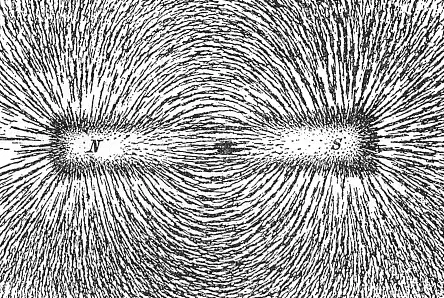
The filings naturally separate from each other because similar poles repel each other. The filling of irons form a pattern that resembles to field lines.
Magnetic Field Intensity
The magnetic field intensity (H) at a point is defined as the force experienced by the unit north pole at that point. Tesla is the unit of magnetic field intensity.
The magnetic field(B) inside the material is;
B= B0+Bm
µH = H + µM
H = (B/µ)-M
Where,
- B is the magnetic flux density
- M is the magnetization
- μ is the magnetic permeability
Origin of a Magnetic Field
The magnetic field generates when a charge in motion. The charge comes into motion in two ways.
- When a conductor carries a current
- When there is motion of electrons around the Nuclei of Atoms
We will discuss the above phenomenon in detail.
Magnetic Field created by a Current-Carrying Conductor
André-Marie Ampère experimented on a current carrying conductor and proposed that a magnetic field generates around a current carrying conductor. The magnetic field near the current carrying wire is stronger, and it reduces as we move away from the wire. Also, the magnetic field increase proportionally with an increase in the current.
According to ampere law, the equation gives the magnetic field at a distance r from a long current-carrying conductor I. In the below given equation, µ0 is a special constant known as the permeability of free space(µ0=4π×10-7 T⋅ m/A).
Magnetic Field Formula
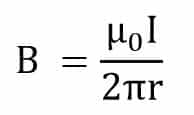
The magnetic field produced by the current carrying current has magnitude and direction. The direction of the magnetic field can be found by the Flemings right hand rule or Screw rule. Wrap your right hand fingers around the conductor with pointing out your thumb in the direction of current flow. The fingers shows the direction of magnetic field.
Motion of Electrons around the Nuclei of Atoms
The permanent magnet functions on the principle of motion of electrons around the nuclei. The following conditions must fulfill to have a material as a permanent magnet.
- The electrons of the atoms do motion around the nuclei. The electrons are paired in such a way that the magnetic field produced by them cancels out. This happens when the electrons spin in opposite direction. The necessary condition for a material to be magnetic is that we need to have more unpaired electrons with the same spin. The iron has four such unpaired electrons with the same spin. Therefore, iron is the right material for making magnets.
- The atoms of the material must have regular orientation. A small piece of ,material has billions of atoms. The magnetic field cancels out if they are randomly oriented, despite having many unpaired electrons. Therefore, the material should be stable at room temperature for establishment of overall preferred orientation to allow an overall preferred orientation for making it as magnet. The permanent magnet has permanent orientation of the atoms.
- Atoms of the some material gets aligned on application of external magnetic field. In the presence of external magnetic field, all the electrons spins in the same direction and cause magnetization of the material. The material remains magnetize till application of the external magnetic field. However, the alignment vanishes after removing of external field. These types of materials are known as paramagnetic.